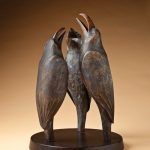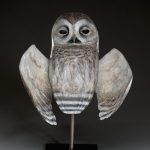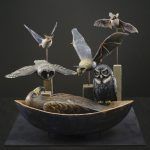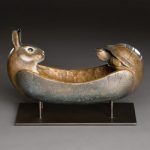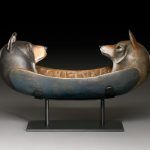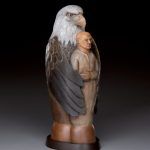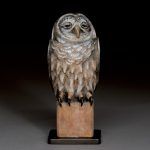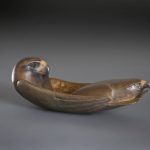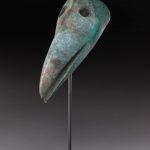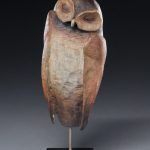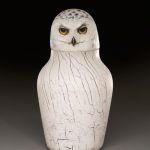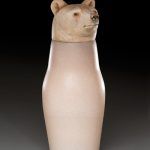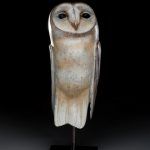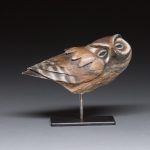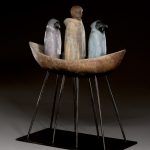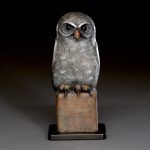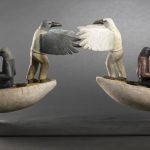Hib Sabin explores the human condition through myth and symbol
By Bonnie Gangelhoff
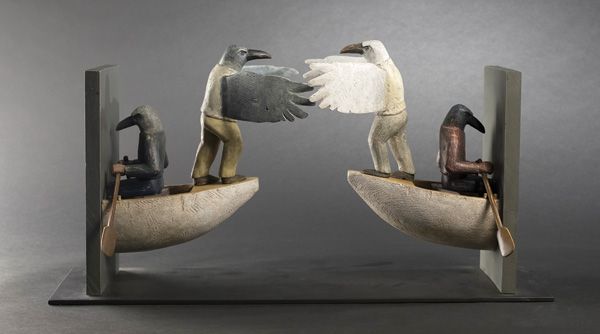
Hib Sabin, Embracing the Essence, juniper/pigments, 14 x 26 x 13.
This story was featured in the June 2017 issue of Southwest Art magazine. Get the Southwest Art June 2017 print issue or digital download now–then subscribe to Southwest Art and never miss another story.
Ask Hib Sabin what inspires his sculptures and he is likely to recite a litany of poets’ names—Dylan Thomas, William Butler Yeats, and Robert Frost among them. And, as if to emphasize his passion for the written word, he may, on occasion, actually read the poem that inspired a piece to a curious art enthusiast. A recent Sabin sculpture titled THE SLEEP OF REASON is a good example. In this sculpture, Sabin references Yeats’ 1919 poem “The Second Coming,” which features these oft-quoted lines: “…The falcon cannot hear the falconer; / Things fall apart; the center cannot hold; / Mere anarchy is loosed upon the world…” For Sabin, the lines speak to the current unsettling times here in the United States and abroad.
But to imply that poetry is Sabin’s sole inspiration in THE SLEEP OF REASON—or for any of his artwork—would not do justice to the breadth and depth of his influences. At 82, Sabin is a man who has lived long and seen much. He has traveled and lived among peoples around the globe and experienced the spiritual and cultural traditions they practice. The artist, who lives in Santa Fe, has visited Northwest Coast Native Americans and spent time with both the Hadza people in Africa and the curanderos (healers or shamans) in Mexico. They all have nurtured his interest in myths and symbols.
- Hib Sabin, Raven Talk, bronze, 17 x 12 x 12.
- Hib Sabin, Repose, bronze, 16 x 13 x 10.
- Hib Sabin, The Sleep of Reason, juniper/pigments, 15 x 17 x 17.
Sabin is a contemporary Renaissance man with extensive knowledge in many fields, one of which is art history. So it is not surprising that THE SLEEP OF REASON is also inspired by a work of art, Francisco de Goya’s late-18th-century etching of the same title. The etching depicts a man sleeping peacefully but surrounded by ominous-looking owls, bats, and cats. Similarly, Sabin’s haunting sculpture features a falcon sleeping in a canoe, behind which rises a cast of nightmarish winged creatures.
While Sabin doesn’t consider himself a social realist or a political commentator, the sculptor says there is a similar message in Goya’s etching and his sculpture: If man doesn’t listen to reason (or “hear the falconer”), “monsters” are born, not just in dreams but in waking hours. “THE SLEEP OF REASON reflects the chaos in our times,” Sabin says. “When reason goes to sleep, chaos comes in.” Sabin believes there is also another possible interpretation—artists need reason in combination with imagination to create art.
THE SLEEP OF REASON is one of Sabin’s 15 wood and bronze pieces on view in a show opening this month at Manitou Galleries in Santa Fe. Matt Mullins, the gallery’s marketing coordinator, says that Sabin’s works evoke a sense of mystery that comes from the pieces feeling both ancient and contemporary simultaneously. “People are drawn to the mysterious and the sacred,” Mullins says. “There is a need in our society for people to feel closer to nature and the spiritual aspects of our lives. Sabin’s work acts as a bridge to connect us with those facets of existence that we crave so much in today’s world.”
- Hib Sabin, Tortoise and Hare Spirit Canoe, bronze, 8 x 12 x 6.
- Hib Sabin, Bear Wolf Spirit Canoe, bronze, 12 x 20 x 8.
- Hib Sabin, Coming Home, bronze, 18 x 7 x 8.
In Sabin’s upcoming July show at Stonington Gallery in Seattle, WA, viewers can see more of his signature imagery of ravens, raptors, owls, bats, bears, boats, and canoes. “The animals are stand-ins for humans,” Sabin explains. “The boats and canoes carry humans between the spirit and human worlds as well as through the different periods in their lifetimes. You have to die in the old period to move on to the new.”
Indeed, universal themes of transformation and journeying are common in his artworks, including the transitional moments between life and the afterlife. Regardless of where and when people have lived, Sabin believes some myths and images are timeless, and he employs these universal symbols in his sculptures as well as his talking sticks, animal spirit bowls, and masks.
In Sabin’s Stonington Gallery show, he also continues his personal journey of exploring the human condition. The show, titled The Long Game, originates, in part, from the lyrics in the ballad “Leaving the Table,” written by modern-day poet and troubadour Leonard Cohen. The song is from Cohen’s last album, You Want It Darker, released in October 2016, a few weeks before he died. “I’m leaving the table. I’m out of the game,” Sabin says, reciting favorite lines from the song. Cohen was 82 when he passed away, and Sabin points out that he is the same age. The lyrics resonate with him. Sabin explains that he, too, has left the table or “gotten out of the game,” meaning, among other things, that he has reached a point in life where he no longer cares what people think about him or his art.
- Hib Sabin, Dreaming Guardians II, bronze, 23 x 18 x 5.
- Hib Sabin, Old Owl, bronze, 9 x 4 x 3.
- Hib Sabin, Passing the Spirit On, bronze, 6 x 17 x 7.
Rebecca Blanchard, co-director of Stonington Gallery, is enthusiastic about Sabin’s works, noting that they possess a deep spirituality. “There’s a feeling that there is far more happening beneath the surface of wood and paint,” Blanchard says. “His larger and more complex
vignettes are often allegories, references to philosophical ideas, or a reimagining of myths from around the world. Even if viewers aren’t familiar with the works of Roland Barthes or Jean-Paul Sartre, they can understand the thrust of the work. It operates on a subconscious level.”
Sabin was born in 1935 in Baltimore, MD, and grew up in an Episcopalian family that moved frequently. Both his father and stepfather served in the military. Sabin developed an early interest in art, and he was fascinated by the Matisse and Picasso prints that graced the walls of his uncle’s home. In his teens, Sabin attended St. Albans School in Washington, DC, a prep school with a stellar art program. When he graduated, he was already painting in oils and knew he wanted to pursue an art career, and he enrolled in and graduated from a joint art program between the University of Pennsylvania and the Pennsylvania Academy of Fine Arts in Philadelphia. Soon after, in 1962, he earned a master’s degree in art history from the University of Pittsburgh. That same year he landed a teaching position on the faculty at Dickinson College in Carlisle, PA. For the next seven years, Sabin taught at the college and painted in his free time. There were many influences on his art during that period. For a time, Sabin adopted an Oriental painting style, creating gouache and watercolor landscapes on rice paper; during another period, he dove into abstract expressionism, creating abstract landscapes from acrylic paint and sand.
- Hib Sabin, Raven Mask, bronze, 20 x 6 x12.
- Hib Sabin, Sleeper, bronze, 11 x 4 x 3.
- Hib Sabin, Snowy Owl, glass/juniper, 17 x 9 x 9.
In 1970, wanting to spend more time on his art, he moved to the arty enclave of San Miguel de Allende in Mexico, which to this day is a mecca for expatriates, writers, and artists. It was during his years in Mexico that Sabin encountered the shamans and curanderos and explored their beliefs in the spirit worlds. His art evolved as he incorporated birds and female figures into his oeuvre.
During the 1970s, Sabin continued to paint but eventually felt a calling to take social action. By 1978, he had stopped painting altogether, moved to Austin, TX, and joined the peace movement. He took part in demonstrations and led peace groups to the former Soviet Union. He also began making regular trips to Santa Fe, NM. And in 1981, he once again pulled up stakes, settling this time in Santa Fe, where he has lived for more than 35 years.
Sabin says he feels at home amid the mix of Native American and Spanish traditions in the City Different and, as well, appreciates its cultural offerings—the opera, symphonies, and arthouse cinemas. It was also in Santa Fe that he got involved with Sister Cities International, a program which took him to Bukhara, Santa Fe’s sister city in Uzbekistan, among other destinations.
In 1991 Sabin returned to his art after a decade’s absence—this time reincarnated as a sculptor. He began to blend his vast cultural knowledge into the carved wooden pieces he is known for today. His medium of choice: New Mexico’s native juniper wood found in the Silver City area. Some have compared Sabin’s works to carvings from the Coast Salish people in the Pacific Northwest. But the artist is quick to point out that he doesn’t use a formline, as they do, and that his work brings together many traditions from around the world, while Coast Salish artwork specifically reflects the culture’s own traditions.
- Hib Sabin, Spirit Bear, glass/juniper, 21 x 8 x 10.
- Hib Sabin, Still of the Night, bronze, 16 x 6 x 6.
- Hib Sabin, Twilight, bronze, 7 x 9 x 4.
Sabin says he finds three-dimensional work more satisfying than painting. He relishes the tactile nature of the juniper and uses it exclusively in his carvings. For years he has stuffed his shirt pocket with tiny fetishes—owls, wolves, and ravens—crafted by the Pueblo Indians. “They are like talismans or good-luck charms,” he says.
Blanchard calls Sabin a medium and a deep thinker who knows how to guide viewers to his message as well as their own. “There is a very specific thing that happens when a collector connects with a Sabin piece. It’s a physical reaction—an almost tangible aura that appears—that we have seen many times,” Blanchard says. “It’s almost as if a connection is hap-
pening at a metaphysical level, and it’s often instantaneous. Clients come to Hib’s shows to commune with the spirits of his pieces and to ponder the ideas behind them. For us in the gallery there is a special kind of peace that suffuses the gallery when he has an exhibit. I think we all dream a little deeper.”
representation
Manitou Galleries, Santa Fe, NM; Stonington Gallery, Seattle, WA; Mockingbird Gallery, Bend, OR.
- Hib Sabin, Voyage to the End of Time, bronze, 19 x 16 x 8.
- Hib Sabin, Young Owl, bronze, 8 x 4 x 4.
- Hib Sabin, Embracing the Essence, juniper/pigments, 14 x 26 x 13.
This story was featured in the June 2017 issue of Southwest Art magazine. Get the Southwest Art June 2017 print issue or digital download now–then subscribe to Southwest Art and never miss another story.
MORE RESOURCES FOR ART COLLECTORS & ENTHUSIASTS
• Subscribe to Southwest Art magazine
• Learn how to paint & how to draw with downloads, books, videos & more from North Light Shop
• Sign up for your Southwest Art email newsletter & download a FREE ebook






